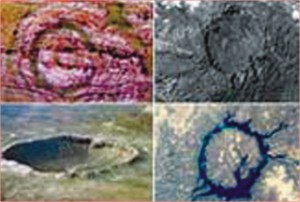Science Feature
Holes in the Earth: 170 and Counting
Clara Moskowitz
 WHEN a meteorite struck Earth before humans were around to watch, did it still make a "splat?" Although it's too late to witness the many pummelings our planet has already seen, scientists are still finding the humongous holes left here long ago impacting space rocks. WHEN a meteorite struck Earth before humans were around to watch, did it still make a "splat?" Although it's too late to witness the many pummelings our planet has already seen, scientists are still finding the humongous holes left here long ago impacting space rocks.
At last count, there were more than 170 known impact craters on our planet, according to the Earth Impact Database maintained by the University of New Brunswick in Canada. These puncture wounds are littered over every continent, as well as the seafloor.
There would be countless more if it weren't for Earth's constant remodeling. Plates shift, mountains form, volcanoes erupt and erosion washes over the planet's surface, continually hiding the evidence of most craters.
"If there was no erosion or tectonic activity, we would look like the moon," said Lucy Thompson, a geologist at the University of New Brunswick. "The moon is just pockmarked with impact craters."
Puzzling differences
Scientists think the Earth was bombarded more heavily earlier in the solar system's history, when planets were still forming and bushels of debris were flying madly around. Luckily for us, things have quieted down lately and meteorite impacts are few and far between.
One of Earth's most recently-formed holes is Arizona's Barringer Meteor Crater, created around 50,000 years ago. Though this crater, one of the most famous, awes tourists with its roughly three-quarters of a mile (1.2 km) diameter, it is considered quite dinky on the geological scale.
"That's a nice, simple bowl-shaped crater," Thompson said.
Geologists get really excited about complex craters, such as Manicouagan in Quebec, Canada. Scientists estimate this crater is more than a thousand times wider than Barringer, and was made more than 200 million years ago.
"With large impacts, you have complex craters forming, and instead of having a nice bowl shape, you get a central uplift," Thompson told SPACE.com. "It's like if you drop something in water, you get rings forming, but the middle comes back up."
Scientists want to understand how the rock achieves this without actually becoming liquid or shattering into pieces.
Big and bad
A major heavyweight is South Africa's Vredefort crater, which at 186 miles (300 km) wide, is said to be Earth's largest verified impact crater. At more than 2 billion years old, it is also one of the most ancient.
Other contenders are the 155 mile-wide (250 km-wide) Sudbury Basin in Ontario, Canada, and the roughly 110 mile-wide (180 km-wide) Chicxulub crater, half submerged off the coast of the Yucatán Peninsula in Mexico.
The latter can claim fame as the landing spot of the asteroid that purportedly killed the dinosaurs, along with most life on Earth.
If it weren't for erosion and other geological processes that erase evidence of craters, there would likely be hundreds of thousands of impact craters on the Earth, Thompson said. Scientists are still discovering new craters, especially in remote areas and on the seafloor where evidence of them is easily missed.
Source : space.com
| 